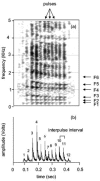Low frequency groans indicate larger and more dominant fallow deer (Dama dama) males
- PMID: 18769619
- PMCID: PMC2518835
- DOI: 10.1371/journal.pone.0003113
Low frequency groans indicate larger and more dominant fallow deer (Dama dama) males
Abstract
Background: Models of honest advertisement predict that sexually selected calls should signal male quality. In most vertebrates, high quality males have larger body sizes that determine higher social status and in turn higher reproductive success. Previous research has emphasised the importance of vocal tract resonances or formant frequencies of calls as cues to body size in mammals. However, the role of the acoustic features of vocalisations as cues to other quality-related phenotypic characteristics of callers has rarely been investigated.
Methodology/principal findings: We examined whether the acoustic structure of fallow deer groans provides reliable information on the quality of the caller, by exploring the relationships between male quality (body size, dominance rank, and mating success) and the frequency components of calls (fundamental frequency, formant frequencies, and formant dispersion). We found that body size was not related to the fundamental frequency of groans, whereas larger males produced groans with lower formant frequencies and lower formant dispersion. Groans of high-ranking males were characterised by lower minimum fundamental frequencies and to a lesser extent, by lower formant dispersions. Dominance rank was the factor most strongly related to mating success, with higher-ranking males having higher mating success. The minimum fundamental frequency and the minimum formant dispersion were indirectly related to male mating success (through dominance rank).
Conclusion/significance: Our study is the first to show that sexually selected vocalisations can signal social dominance in mammals other than primates, and reveals that independent acoustic components encode accurate information on different phenotypic aspects of male quality.
Conflict of interest statement
Figures



References
-
- Andersson M. Sexual selection. Princeton, NJ: Princeton University Press; 1994.
-
- Doty GV, Welch AM. Advertisement call duration indicates good genes for offspring feeding rate in gray tree frogs (Hyla versicolor). Behav Ecol Sociobiol. 2001;49:150–156.
-
- Christie PJ, Mennill DJ, Ratcliffe LM. Pitch shifts and song structure indicate male quality in the dawn chorus of black-capped chickadees. Behav Ecol Sociobiol. 2004;55:341–348.
-
- Fischer J, Kitchen DM, Seyfarth RM, Cheney DL. Baboon loud calls advertise male quality: acoustic features and their relation to rank, age, and exhaustion. Behav Ecol Sociobiol. 2004;56:140–148.
-
- Vehrencamp SL. Handicap, index, and conventional elements of bird song. In: Espmark Y, Amundsen T, Rosenquist G, editors. Animal Signals: Signalling and Signal Design in Animal Communication. Trondheim: Tapir; 2000. pp. 277–300.
Publication types
MeSH terms
LinkOut - more resources
Full Text Sources

